How to choose a garage heating option: the most economical method that does not pose a fire risk
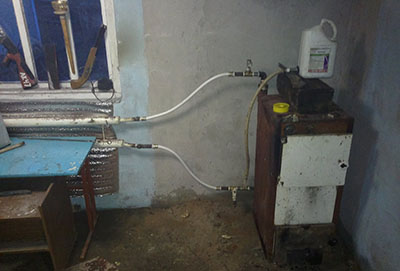
Heating is being installed in the garage as for permanent heating during the cold season, and for periodic, for example, during repair work.
The second option is significantly cheaper in terms of costs.
To select the most economical heating method in different circumstances, the following will be considered: several common options.
The most economical way to heat a garage
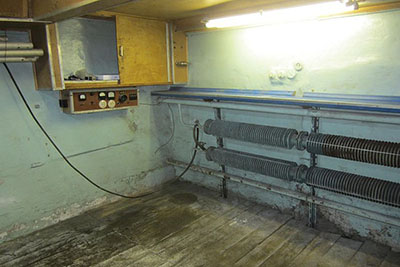
To choose a profitable heating method, take into account the following circumstances:
- what communications are there in the garage (electricity, gas, heating system in a nearby house);
- readily available fuels (wood waste, waste oil, gas);
- goals (if repair work is planned once a month, it is not worth organizing a heating system with a boiler, pipes and radiators);
- quality of garage insulation.
Attention! Constant heating of a poorly insulated garage - waste of money.
Autonomous water variant
The heating system is considered to be such. with a boiler or stove, located directly in the garage.
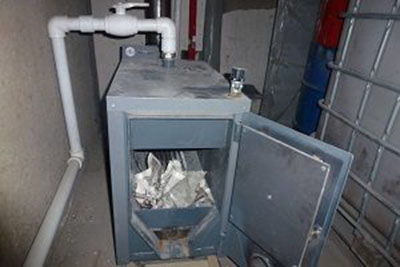
Another option is to connect the garage to the water heating system, located next to the house.
The general principle of operation of liquid heating is to heat the coolant using a boiler or furnace, and then heat the surrounding space from radiators (batteries) filled with hot liquid.
The outline of such a system closed.
If water is used as a coolant, then Cooling the system to sub-zero temperatures is not allowed: When water freezes, it expands and can burst the pipes and radiators it is in.
Reference! Antifreeze (non-freezing liquid) will help to avoid risk of system freezingIt is considered unsafe for health in case of leaks, but for a garage, where people are less frequent than in living quarters, and a small area allows you to control leaks, this option is relevant.
The following are used as heating units:
- solid fuel stove;
- gas boiler;
- electric boiler;
- waste oil furnace.
A stand-alone system suitable for a garage includes the following parts:
- a boiler (or furnace) that heats the coolant (water or antifreeze);
- expansion tank;
- pipes;
- radiators (batteries).
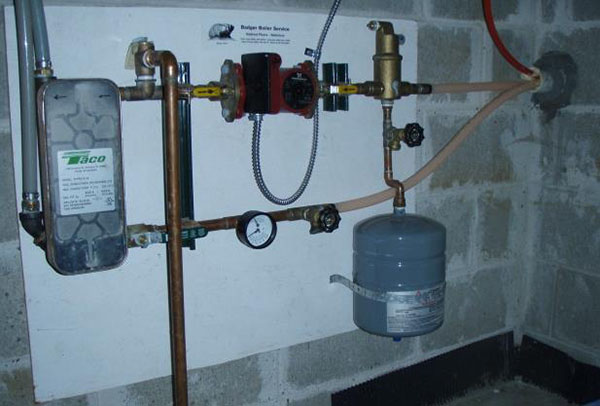
Photo 1. Boiler, expansion tank, pipes, circulation pump - elements of an autonomous garage heating system.
In addition, other equipment is installed for specific purposes (pump, boiler, sensors, timers). In case of using any boilers except electric ones, chimney.
Pros:
- Possibility of making garage heating regardless of the availability of communications (for example, in the absence of electricity, they heat with wood);
- constant heating;
- economy in the presence of cheap fuel (for example, free waste);
- when installing a boiler, the system can also serve as a source of hot water;
- the ability to cook food on stoves.
Cons:
- costs of time and money for equipping the system;
- demand for main gas for economical operation;
- the need for constant firewood storage for a solid fuel boiler;
- fire hazard, including due to the presence of fuel and heating of the chimney;
- requirement to maintain a constant positive temperature when using water as a coolant;
- Each type of boiler has its own additional advantages and disadvantages.
Gas method
Here are various options, excluding water:
- Heat gun. This is a powerful air heater, different modifications of which operate on gas, electricity or diesel fuel. Gas for the gun is used in cylinders. This option is suitable for work in the garage: the room quickly warms up, the required temperature is maintained throughout the work, and during non-working hours the equipment is cooled to sub-zero temperatures.
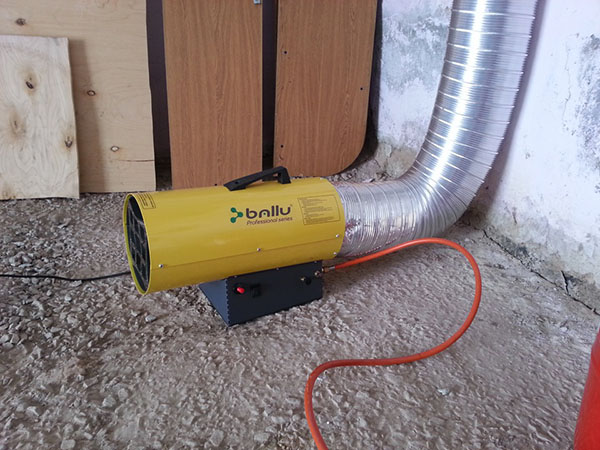
Photo 2. Heat gun from the manufacturer Ballu, works from a gas cylinder, quickly warms up the room.
- Gas heater with infrared heating. This type of heating is based on the action of electromagnetic oscillations of a certain spectrum. The peculiarity is that it heats not so much the air as the objects to which the heater is directed. And they then give off heat to the surrounding space. Solar energy acts similarly. Heating with infrared rays occurs quickly.
Peculiarities
If gas is used in the garage, it is required regular ventilation, as well as compliance with safety precautions when storing cylinders.

Pros:
- independence of heating from the availability of electricity;
- fast heating;
- the ability to warm up the garage only at the required hours.
Cons:
- combustion products in air require regular ventilation of the room;
- fire hazard due to the use of gas.
Attention! An explosion of a gas cylinder in a garage cooperative could lead to to a major fire and damage to a large number of vehicles.
Electric heating method
Most often, garages are electrified, which makes it possible to install convenient electric heating:
- Oil heaters. This traditional and familiar option is not economical. And it will not heat the room quickly, especially if it is poorly insulated.
- Infrared (IR) heaters. This type of device is perfect for garages (often poorly insulated), since it is not the air that is heated, but the people and objects that the device is aimed at. Therefore, such devices are used even outdoors.

Photo 3. Oil electric heater, heats the room slowly if the garage is poorly insulated.
It makes sense to place it in the garage ceiling versions. They are economical and have different power options. For heating 10 sq. m. On average, you need an IR heater with a power of 1 kW. In this case, in the absence of people, the device can be used economically at reduced power, and in their presence, at full power.
- Convectors. They heat the air passing through the device's grilles using heating elements. They heat the room fairly quickly and are safe.
Ways to save money with electric heating:
- Installation of a two-phase meter with maximum use of reduced tariff periods.
- Heating only when people are present in the garage.
- Using the timer. If the owner comes to the garage from Monday to Friday at the same time in the morning, on these days the heating devices will be automatically turned on by the timer for the required time (an hour or two).
Important! Read the instructions for the heater and timer. Some devices use a timer. unsafe.
Peculiarities
Heating with electricity is considered expensive. Different devices of this type can be more or less economical.
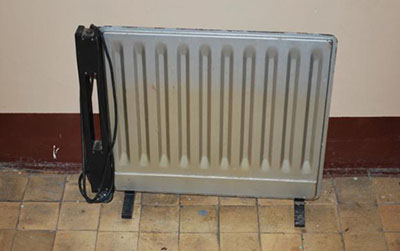
According to some sources, oil heaters are considered the most expensive, convectors are considered the most profitable, and infrared devices are considered the most economical.
Pros:
- speed of heating organization;
- possibility of automation by setting timers;
- cheapness of electrical appliances.
For example, for a garage with an area of 20 sq. m. it is enough to use a ceiling infrared heater with a power 1.5 kW. Its minimum price will be around 4 thousand rubles.
Cons:
- high cost of electricity;
- The devices have heating limitations (oil by heating speed, infrared by the location of the heated object in the device’s directional field).
Solid fuel: stove, potbelly stove
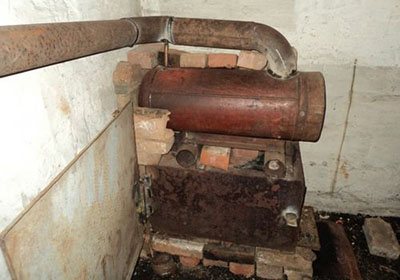
This type of heating will require storing firewood or other fuel nearby, as well as periodic cleaning of the chimney and stove. Labor costs will be associated with with constant supply of firewood.
Small stoves in garages are used independently, without water circuit. If necessary, they can also be used to cook food and heat water.
For safety, high-quality thermal insulation of the stove itself and the chimney is arranged. When in contact with wooden elements Fires are possible.
Pros:
- independence from any communications;
- fuel availability;
- widespread availability of equipment.
Cons:
- high labor costs;
- Garage litter due to firewood use;
- danger of fire and carbon monoxide poisoning.
On waste oil

Inexpensive liquid fuel heaters available on the market are more suitable for cooking using diesel fuel or kerosene. For garages, homemade furnaces for waste oil are often used.
Opinions about the safety of such structures differ: some consider them safe, others write about the possibility of fire.
In any case, the use of waste oil furnaces requires oil storage and is accompanied by with the appropriate smell. It is necessary to ventilate the room.
Pros:
- high heat transfer;
- fast warm-up;
- Oil takes up less space than firewood.
Cons:
- smell;
- the oven needs cleaning;
- Fires of improvised structures cannot be ruled out.
Useful video
Video review of a gas stove, which can serve as one of the ways to heat a garage.
How to choose?
In each specific situation the choice will be individual. Determining factors: frequency of heating use, availability of utilities and cheap fuel.
The most convenient is, of course, electric heating. It also saves time as much as possible. If it is possible to optimize it financially (for example, by purchasing economical devices and using them rarely), this option is recommended most often.






